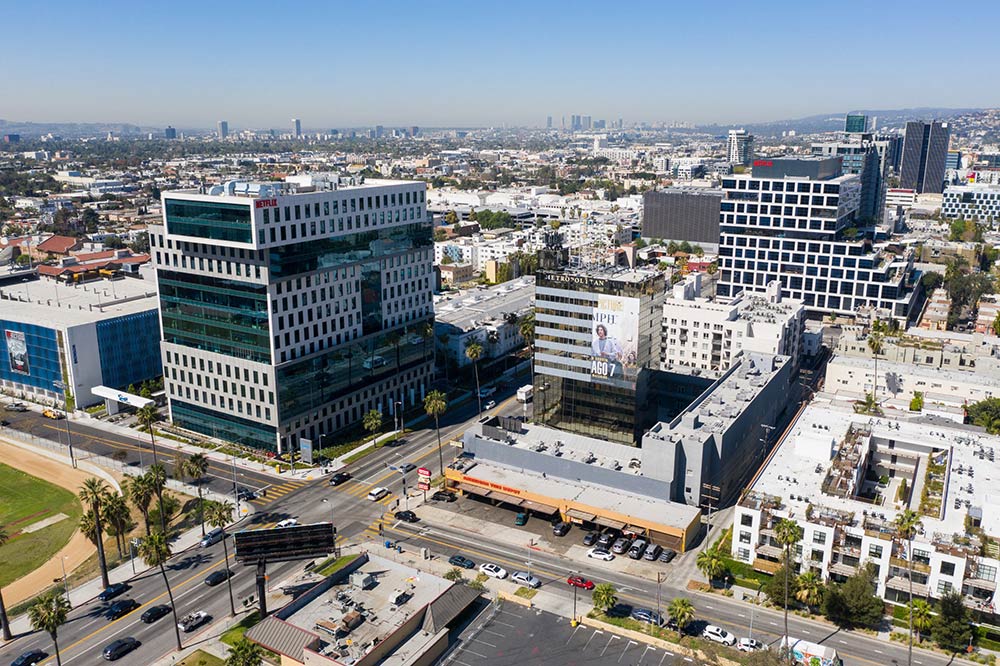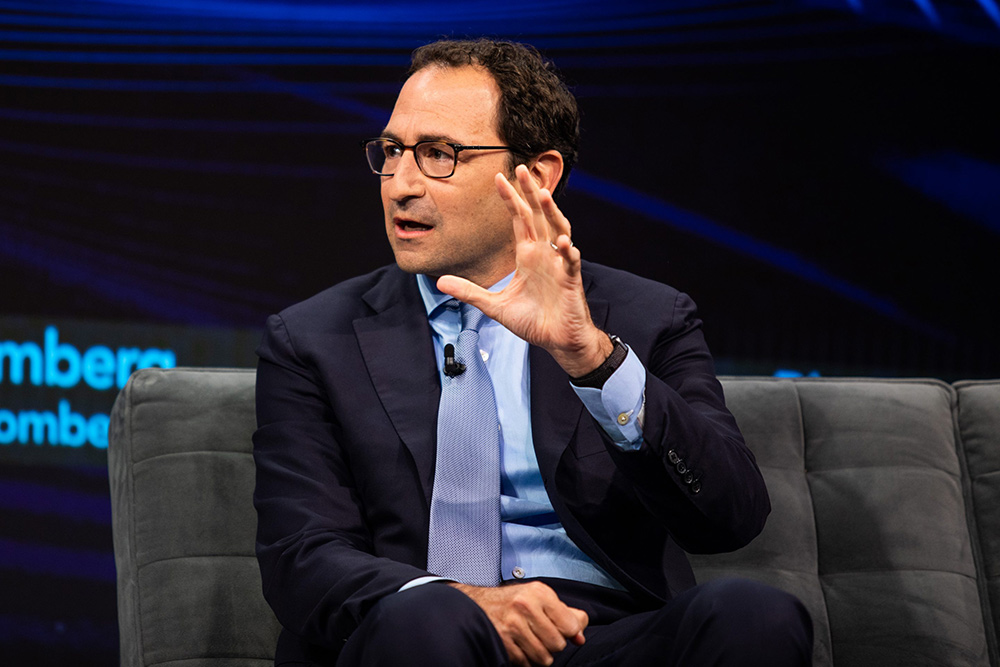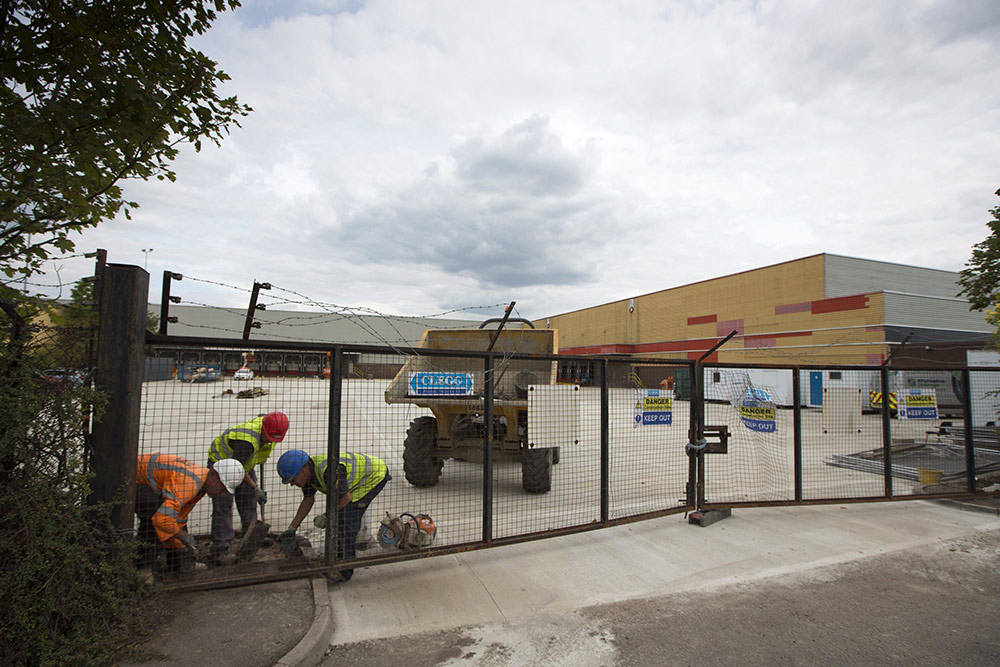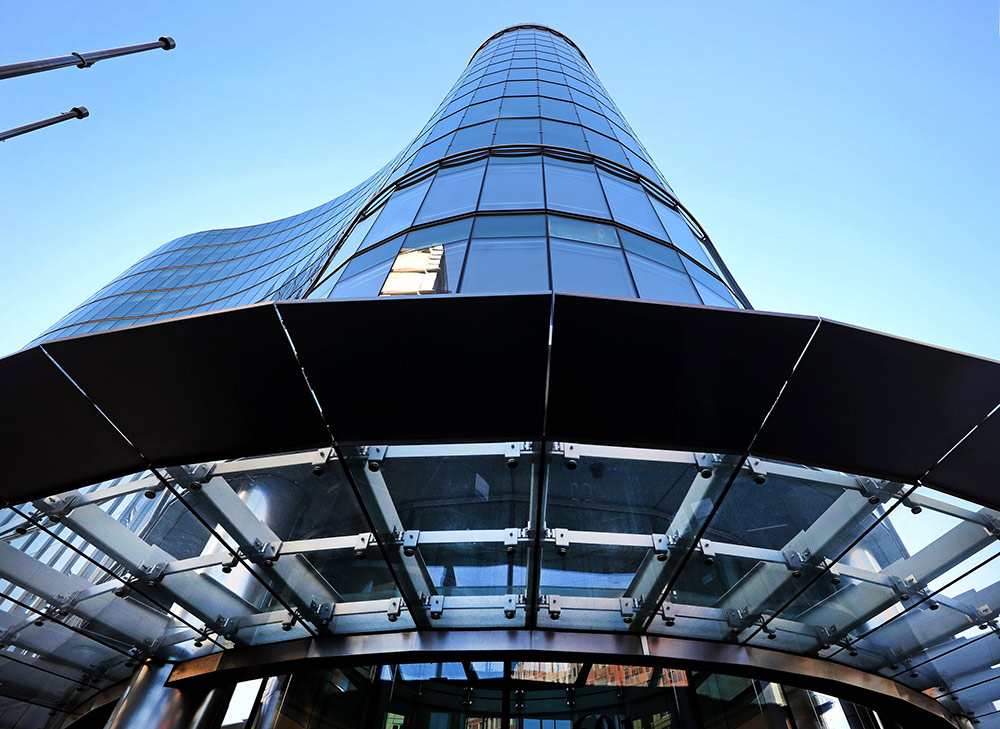6月16日,SOHO中國發布公告稱,私募巨頭黑石發出全面收購要約,投資SOHO中國。交易價格約為236.58億港元(約合30.48億美元),以取得SOHO中國的控股權。交易完成后,SOHO中國現有控股股東將保留9%的股權。
能夠將SOHO中國如此大體量的盤子收入囊中的黑石,經常能夠在最好的時機談下最低的價格,且善于捕捉趨勢,準確找到朝陽領域,借勢得以飛速發展。
這篇文章,將回顧黑石作為全世界最大的商業地產所有者的成功之路。
就在那一刻,納迪姆?梅格吉意識到新好萊塢電影為房地產施了法。
梅格吉在私募股權公司黑石負責美國地產投資。2019年春日的一天,他站在洛杉磯Nerflix大樓14層的屋頂露臺上,俯瞰這家流媒體巨頭位于日落大道上的創意總部。擁擠的停車場,成群結隊的技術人員、編劇、演員和制作人從辦公樓匆匆趕往低矮的攝影棚。
梅格吉的心里很清楚,眼前熱鬧的內容創作中心是全球最好的房地產機會之一。
“這不僅僅是辦公大樓。”他回憶道。“它還是制作爆發式增長的在線娛樂內容的關鍵基礎設施。這里是充分整合的中心,Netflix或迪士尼可以為劇本創作、拍攝、營銷以及其他內容制作流程租下辦公室和工作室。”
在訪問期間,梅格吉和黑石團隊了解到,Nexflix利用長期租約來控制節目策劃和拍攝地,從而節約了巨大成本,迪士尼和亞馬遜也采用了類似的集中策略。這與最近常見的零散模式有所不同,在零散模式下,電影和電視公司會授權個體制片人臨時租用演出辦公室和舞臺。
在梅格吉看來,通過“批量出租”和“集中制作”模式來制作流媒體內容正是黑石渴望的投資類型,最好是租客業務蓬勃發展,即便租金迅速上漲,其他競爭對手也極難插手。
梅格吉從Netflix大樓頂上看到的龐大媒體綜合體,正如歷史悠久白色圓柱矗立的華納兄弟總部,都屬于獨一無二的奇跡,而且面臨的競爭極少。
因此,一年多后的2020年6月,即便在新冠疫情肆虐期間,辦公室和工作室幾乎空無一人,黑石還是宣布將收購洛杉磯這座大樓49%的股份,就是之前梅格吉看中的地方。交易之后,黑石成為企業的共同所有者,經營著美國最大的獨立制片廠之一。
現在黑石是Netflix洛杉磯總部的房東,租客包括Netflix和迪士尼,這讓黑石倍感自豪。在攝影棚里,Netflix的《厄普肖一家》(The Upshaws)和美國廣播公司的《19號消防局》(Station 19)等熱門劇集紛紛開機拍攝,而黑石聯合持有的公司負責管理從舞臺到餐食,再到燈光調試等一系列事務。

收購這座大樓也充分體現了黑石的先見之明。雖然沒有人預見到疫情爆發,但由于黑石在疫情之前和期間實施的房地產戰略恰好因為美國生活方式在危機中的轉變而獲利,所以拿下了精彩一局。
隨著封鎖緩解,黑石也賺得盆滿缽盈。當初黑石之所以敢出資數十億美元,賭的就是其看好的趨勢在房地產領域勁頭穩健。
“最確信”主題
黑石的好萊塢冒險之旅體現了其投資理念:找到相對少有人關注且比其他類型房地產更高回報的通道,而且要盡早進入。黑石是華爾街的領軍者,也是全世界最大的商業地產所有者。目前黑石管理的投資者資本約1960億美元,杠桿放大后持有資產價值3780億美元。
盡管規模龐大,黑石卻具有非凡的靈活性。過去幾年里,其較保守也較長期投資的回報率一直維持在較低兩位數,偏重機會的投資回報率則遠高于該水平。
之所以回報穩健,是因為黑石及時退出了迅速衰退的領域,特別是美國郊區購物中心和建設過度的城市辦公室,轉向了另外四個方向,都是之前少有觸及但后來蓬勃發展的領域。
黑石將新方向稱為“最確信主題”,具體包括倉儲物流、郊區公寓、生命科學和電影公司。每類投資都能夠抓住上升浪潮。
房地產聯席主管凱瑟琳?麥卡錫表示,在倉儲物流、房屋租賃和電影公司方面,疫情“加速了危機前就已經開始的趨勢”。
黑石的目標并不是將數十億資金分散到房地產各大類別和市場以降低風險。梅格吉稱:“投資集中在我們預測技術和人口結構變化將催生巨大需求的領域。”
黑石認為,電子商務可以刺激冷清的倉儲業。在競爭對手放松之時,黑石卻迅速出手,通過一系列重大收購組建了全球第二大配送中心,僅次于全球最大的物流地產運營商安博。
疫情之前黑石就在發展迅速的陽光地帶公寓下了重注,正好最近不少單身人士和家庭離開市中心搬到郊區,空置率降低,租金提升。
在生命科學方面,黑石認為,如果將辦公室提供給研究突破性療法的實驗室,發展會比普通辦公室好。
就在黑石宣布投資電影公司之后一年里,美國人紛紛居家生活,消費了大量新電視劇,這個現象鼓勵Netflix及其競爭者不斷擴大辦公室和攝影棚,從而制作更多節目。
當然,黑石私募股權業務很強大,但房地產是其最大的利潤來源。最近幾年,該公司因為一系列收購而頻頻登上新聞頭條,包括收購拉斯維加斯大道上的大都會酒店和貝拉吉奧酒店、紐約市最大的公寓大樓Stuyvesant Town、還有印度班加羅爾的大使館辦公區,也是印度IT企業云集之地。
但是,向疫情中繁榮發展的領域大步轉移卻并未引起什么轟動。而且重新定位確實是大勢所趨。十年前,黑石持有的資產中只有2%是倉庫和公寓,在電影公司或生命科學領域甚至還沒有起步。如今,四大主題已經占黑石全球投資組合的五分之四。

特別值得一提的是,黑石不僅實現了轉型,期間還大幅增加了總資產規模。從2015年年底到今年一季度,黑石房產投資資本翻了一番,從930億美元增至1960億美元。在去年290億美元的巨額房地產新投資中,92%投向了高度優先的領域。疫情經濟也正在為其注入新活力,一季度黑石持有房地產利潤達到5.47億美元,是去年同期的兩倍。在過去五年里,黑石的股價上漲了253%,投資者的年回報率達36%,超過了同期標準普爾500指數19個百分點。
大基金好做生意
黑石管理著兩類基本類型基金,都已經大幅傾向旗下四大基礎行業。
最初是機會型地產基金BREP,面向大型機構投資者,例如得克薩斯教師退休體系和佛羅里達州管理委員會養老基金等。BREP組合的主要操作方式是短時間內快速運作。
黑石的總裁兼首席運營官喬恩?格雷曾經將該模式稱為“買入、修復、賣出”。具體計劃是,購買破舊、空置或住客稀少的不良房產,注入資本翻新,組建新管理團隊,隨著大樓擠滿租戶且租金不斷上漲,黑石爭取在五年內退出并獲得巨額收益。
自1994年BREP成立以來,黑石已經在美國、歐洲和亞洲推出17只基金,扣除管理費后向投資者提供的年平均收益為16%。
如今,BREP管理的房地產和“干火藥”現金(即可用于投資的資金——譯者注)已經近1000億美元,也成為全球最大的單一房地產私募股權基金。
第二類屬于黑石的核心增益型(CORE+)戰略。相關投資組合中的建筑在黑石收購時已經可以產生強勁穩定的現金流。BREP的目標是迅速獲得暴利,CORE+希望長期持有房產,通過租金收入和租金上漲推動的升值來回報投資者。CORE+則是兩者之間的橋梁。黑石財產合伙人計劃(簡稱BPP)基金于2014年成立,為同樣投資于BREP的養老基金和捐贈基金提供低兩位數的年收益率。在短短七年里,BPP管理的資產迅速增加到約500億美元。

最近,黑石首次大規模吸引散戶投資者。CORE+的第二個支柱是2017年推出的黑石房地產收益信托,簡稱為BREIT,目標是“大眾富裕階層”。BREIT是一種房地產投資信托,投資者持有份額,但份額并不參與交易。
像BPP基金一樣,BREIT不買舊樓改造。在價值460億美元的近1400處房產投資組合中,四分之三都是倉庫和郊區公寓,兩類均包括在“最確信”主題里,地段在繁華的陽光地帶大城市,全部用于出租賺取大筆租金。
募集龐大基金提供數十億隨時可用的現金,這是黑石在市場上一大優勢。不管是將上市公司私有化,還是收購龐大的投資組合,黑石能夠做到一次交易買下大規模資產。與缺乏資金競購交易的競爭對手相比,這就是巨大優勢。
簡單來說,黑石通過批量購買可以談下最低價格。正如2020年房地產收購主管泰勒?亨利茨接受《財富》雜志采訪時所說:“如果一棟價值2000萬美元的辦公樓要出售,可能有20個競拍者。如果是200億美元的交易,競爭就會少得多。”收購規模龐大的資產,然后分拆出售給缺乏現金的競爭對手賺取豐厚利潤,黑石已經十分精于此道。
新范式
2010年前后,經濟在從金融危機中復蘇,當時黑石的投資組合與目前截然不同,超過四分之三的投資是酒店和辦公樓。2007年,黑石完成了兩宗巨額交易,分別是收購希爾頓酒店集團和美國最大商業物業集團EOP公司。最終黑石以可觀的利潤出售了兩家公司,但都經過了多年艱苦努力改進經營。
到了2011年,黑石開始規劃新方向。當時擔任房地產主管的格雷以及現任聯席主管麥卡錫和肯?卡普蘭,在黑石尚未涉足或剛開始投資的領域發現了極為強勁的增長潛力,也就是現在的“最確信”領域。
他們還決定將相關投資集中在兩類地區:第一類是格雷所謂的“人才型”城市,比如舊金山、洛杉磯和西雅圖,因為此類城市吸引了最優秀也最聰明的科技和媒體人才;其次是美國發展最快的城市,主要是亞特蘭大、達拉斯和菲尼克斯等陽光地帶城市,危機后復蘇啟動之際,此類城市在創造就業機會方面領先全美。BPP基金和BREIT的推出擴大了黑石的業務范圍,囊括了發展勢頭最佳的房地產。
另一方面, 黑石發現本世紀初占主導地位的領域發展機會越發渺茫。
2010年,黑石認為電子商務雖然依舊處于初級階段,但已經從封閉的購物中心搶奪銷售額,而購物中心是之前幾十年最好的資產。2012年黑石賣掉了美國最后一家大型購物中心,到2015年退出了絕大多數沿街購物中心。如今,黑石的基金里已經完全沒有零售物業。
格雷認為,傳統辦公室的發展趨勢是壓縮員工空間,做成彼此緊挨的小隔間,最終會抑制對低質量建筑的需求。在紐約市等傳統上發展強勁的市場,2010年代中后期繁榮時期很多新樓拔地而起,對租金造成下行壓力。黑石在北美繼續購買并持有辦公樓,但主要在科技行業實力強大且不斷增長的城市,尤其是溫哥華、西雅圖和舊金山。
“西雅圖非常適合投資辦公室,因為它是全世界云計算之都。”梅格吉說。
盡管如此,在過去十年內,黑石還是大筆減持美國辦公物業。黑石也在減持酒店,不過它認為多數城市里的酒店建筑水平在提升。因此,公司重點關注規模更大的度假地產,位置都在很難建造新酒店的海灘。
與此同時,黑石開始大舉轉向四個“最確信”領域,最先一步就是進軍倉儲行業。
愛上倉儲業
黑石開始購買外觀像大盒子一樣的配送中心,并不是因為覺得長期投資價值高,而是因為實在太便宜。2010年黑石開始出手,當時傳統上就很落后也不吸引人的倉儲行業受到金融危機沖擊,而且比其他行業受創更嚴重。
不過在2020年,格雷曾經告訴《財富》雜志:“我們觀察到趨勢很快會來,租金即將大幅飆升。”
傳統上,倉儲租金增速最多也就是與GDP增長同步。不過黑石團隊認為隨著電子商務的勢頭增強,該行業發展將遠遠超過整體經濟。麥卡錫稱:“我們發現需求出現脫節,增加的供應很少。”
黑石全力以赴,在美國購買了18個投資組合,將相關投資組成名叫IndCor的獨立公司,由BREP旗下一只基金控股。2015年,黑石以81億美元將IndCor賣給新加坡主權財富基金,隨后在歐洲繼續操作,組建了另一家名叫Logicor的配送中心,兩年后以140億美元賣給中國政府的投資部門。兩筆交易的年回報率均超過30%。

與此同時,黑石公司不斷擴大倉儲業投資組合。2019年,黑石募集了205億美元的基金,在商業地產史上排名第一,利用部分收益以及BREIT的資金在38座城市買下了1100個倉庫,其中數十家租賃給亞馬遜。該筆交易187億美元,也成為有史以來最大一宗私人地產交易。
如今,其投資組合中每10美元就有4美元投向了洞穴般的倉儲建筑中,金額高達600億美元。
新冠疫情期間,之前發展穩健的行業迎來爆發,從日用雜貨到蘇打水再到園藝用品,亞馬遜、沃爾瑪、家得寶等電商巨頭將各種商品送往居家的美國人門口。
2012年至2016年,倉庫租金年均上漲3%,之后三年平均上漲6.5%。2020年,增長率上升至7.5%,空置率降至極低的4.6%,約為九年前的一半。
這一熱潮推動銷售價格飆升,導致“收益上限”即每投資一美元獲得的租金凈收入從6%以上降為4%左右。人們以為黑石會將倉庫搬往更便宜的區域應對。
然而事實并非如此。去年,黑石花了90億美元收購更多倉庫,占當年安排“地面”投資的45%。
為何黑石相信新的也更昂貴的收購可以獲得巨大回報?
黑石團隊認為,在迅速擴張的陽光地帶大城市集中收購仍然能夠獲得不錯的回報,例如亞特蘭大、菲尼克斯、達拉斯、奧斯汀和羅利-達勒姆地區等。
此類市場中,黑石主要買距離市中心20公里左右的“補充”位置。客戶愿意為超密集的地區支付高額溢價,因為配送速度快,通常兩小時就可以完成交貨,而且能夠最大程度地覆蓋大量“家庭”。
在黑石看來,靠近客戶的倉庫還有另一個巨大優勢,因為在靠近城市的地區很難再建造倉庫與之競爭。同樣,幾乎沒有對手可以像黑石在一次交易中花費數十億美元買下數百個倉庫,而且是以超快速度完成交易。
花園公寓
熱門的陽光地帶市場都是黑石在郊區租房的主要投資對象。早在2012年,黑石領導者就發現,美國建造的房屋和公寓太少。到2015年,新公寓建設速度大約僅能夠滿足一半加入勞動力市場的年輕人需求,而年輕人都需要公寓。
黑石認為,金融危機后與父母同住、與室友合住的年輕單身人士將推動市場發展。具體預測為:長期短缺將推動租金快速上漲,新建和翻新的花園式公寓幾乎沒有空房。花園式公寓是多戶租賃的行業術語,多位于郊區,特色是配套游泳池和公園。
在疫情來襲之前,該趨勢就已經出現,亞特蘭大和菲尼克斯等黑石最看重的市場租金一直以5%至9%的速度上漲。只是疫情推動進一步加速。
即便在佛羅里達和得克薩斯等州,單身人士和家庭也會把市中心的公寓換成更寬敞的住所,希望住在郊區有露臺、花園和社區游泳池的房子里。
黑石并未透露個別市場的租金趨勢,但其他上市業主的數據顯示,目前陽光地帶城市里租金每年增速都接近10%。
租賃公寓目前占黑石持有資產的五分之一,十年前還只占極小部分。BREIT持有的最多,包括74000套多戶房屋,其中95%均已經租出,主要集中在陽光地帶,從卡羅萊納到佛羅里達,向西穿過得克薩斯、亞利桑那、內華達再到南加州。
生命科學變成房地產投資
2015年,BREP的一只基金斥資90億美元收購BioMed Realty,黑石開始進入生命科學領域,當時BioMed Realty是美國最大的辦公樓房東之一,主要將實驗室租給生物技術公司。該筆交易也將已經上市的房地產投資信托私有化。
與BREP收購的大多數產業不一樣,BioMed經營并無問題。
“市場上普遍誤解了。”梅格吉說,“投資者認為,實驗室空間過于專業,資金太密集,所以低估了潛在需求。”
BioMed的交易價格低于傳統辦公樓,而當時黑石已經基本上不考慮傳統辦公物業。該公司的立場跟黑石一樣喜歡逆向投資,認為在人口老齡化和生物制藥研究支出快速增長的推動下,生命科學領域將實現超快速增長。
黑石還認為,為了挖掘BioMed的潛力,應該把所有辦公室集中在全世界五大科研中心,包括兩個劍橋(馬薩諸塞州和英國)、圣迭戈、西雅圖和舊金山灣區。這些地區最吸引制藥巨頭,因為企業可以在毗鄰麻省理工學院和英國劍橋大學等頂尖研究機構之處租用實驗室和辦公室,便于吸引優秀的科研人員。
正如麥卡錫所說:“這會形成一種聚集效應。制藥公司喜歡靠近大學,也喜歡扎堆,充分享受知識密集的益處。”BioMed在幾處科研中心實力都很強,在規模稍小的科研中心紐黑文、圣路易斯和邁阿密等地也有不少產業。
“我們把小地方的產業全部賣掉,將資本全部投在核心市場。”梅格吉說。黑石向新實驗室和辦公室投入了30億美元,全都在前五大科研中心。
由于BioMed穩定發展,逐漸成為輝瑞、默沙東和百時美施貴寶等客戶的首選房東。疫情期間實驗室一直開放,研究進展也很穩定。
“我們比傳統辦公樓賺的租金更多,租客需求更多。”麥格吉如是觀察。“投資者進入生命科學房地產領域的愿望也大大增加。”
趨勢之下也催生了大交易。
去年10月,持有BioMed的BREP基金以146億美元將其出售給了新成立的BPP公司,投資者收獲了60億美元收益,BPP專門購買穩定成熟地產。在BPP生命科學籌集的資金中,超過三分之二來自最初收購BioMed時BREP基金的投資者。僅兩個月后,BPP生命科學就以34億美元收購了龐大的實驗室辦公樓綜合體,幾乎全部位于馬薩諸塞州劍橋,進一步擴大了其在知名科研中心的產業規模。

如今黑石擁有200億美元的實驗室辦公室資產,而七年前幾乎為零。麥格吉表示,現在只是剛剛開始:BioMed打算不僅繼續收購實驗室,還要在五大科研城市的好地段建造新實驗室。
演藝大時代
2017年黑石第一次搭上好萊塢,當時黑石在加州伯班克買下一些由迪士尼和華納兄弟支持的辦公大樓。黑石又一次發現工作空間具備一些特殊之處則會潛力巨大,如果距離很近,制片人、編劇和高管工作的辦公樓就會更稀缺,價值也更高。
因此在2020年6月,黑石宣布從房地產投資信托 Hudson Pacific Properties(簡稱HPP)的手中購買日落大道綜合體49%的股份。
該綜合體包括三家規模較大的電影公司,即日落布朗森、拉斯帕爾馬斯和日落高爾,包括多個攝影棚和120萬平方英尺(約合11.15萬平米)的制作空間,以及旁邊100萬平方英尺(約合9.29萬平米)的辦公室。
與生命科學一樣,地理位置至關重要:洛杉磯是全球電影和電視產業中心,從業人員在美國占一半,攝影棚在美國和加拿大也占一半。舉個例子,Netflix大部分在美國拍攝的內容都在洛杉磯完成,其中大部分是在黑石聯合持有的制片廠里。

黑石敲定交易時,疫情期間的電影公司一片漆黑,辦公室里空無一人。但現在制作重歸火爆,一家公司同時拍攝的劇目多達10部。過去三年里,前七大制片廠在新節目上支出增長了77%,而隨著播出前景不確定的劇集增加,新節目支出增速更快。
梅格吉強調,黑石-HPP的共同所有人不僅是房東。
他說:“我們更像電影和流媒體公司的看門人,我們安排燈光、音響、拖車和其他各種設備,還負責舞臺管理和餐飲。不能只是想著持有資產,更要經營對內容創作至關重要的平臺。”
弧光燈亮起:黑石公司在美國夢工廠成了動作英雄。(財富中文網)
譯者:馮豐
審校:夏林
6月16日,SOHO中國發布公告稱,私募巨頭黑石發出全面收購要約,投資SOHO中國。交易價格約為236.58億港元(約合30.48億美元),以取得SOHO中國的控股權。交易完成后,SOHO中國現有控股股東將保留9%的股權。
能夠將SOHO中國如此大體量的盤子收入囊中的黑石,經常能夠在最好的時機談下最低的價格,且善于捕捉趨勢,準確找到朝陽領域,借勢得以飛速發展。
這篇文章,將回顧黑石作為全世界最大的商業地產所有者的成功之路。
就在那一刻,納迪姆?梅格吉意識到新好萊塢電影為房地產施了法。
梅格吉在私募股權公司黑石負責美國地產投資。2019年春日的一天,他站在洛杉磯Nerflix大樓14層的屋頂露臺上,俯瞰這家流媒體巨頭位于日落大道上的創意總部。擁擠的停車場,成群結隊的技術人員、編劇、演員和制作人從辦公樓匆匆趕往低矮的攝影棚。
梅格吉的心里很清楚,眼前熱鬧的內容創作中心是全球最好的房地產機會之一。
“這不僅僅是辦公大樓。”他回憶道。“它還是制作爆發式增長的在線娛樂內容的關鍵基礎設施。這里是充分整合的中心,Netflix或迪士尼可以為劇本創作、拍攝、營銷以及其他內容制作流程租下辦公室和工作室。”
在訪問期間,梅格吉和黑石團隊了解到,Nexflix利用長期租約來控制節目策劃和拍攝地,從而節約了巨大成本,迪士尼和亞馬遜也采用了類似的集中策略。這與最近常見的零散模式有所不同,在零散模式下,電影和電視公司會授權個體制片人臨時租用演出辦公室和舞臺。
在梅格吉看來,通過“批量出租”和“集中制作”模式來制作流媒體內容正是黑石渴望的投資類型,最好是租客業務蓬勃發展,即便租金迅速上漲,其他競爭對手也極難插手。
梅格吉從Netflix大樓頂上看到的龐大媒體綜合體,正如歷史悠久白色圓柱矗立的華納兄弟總部,都屬于獨一無二的奇跡,而且面臨的競爭極少。
因此,一年多后的2020年6月,即便在新冠疫情肆虐期間,辦公室和工作室幾乎空無一人,黑石還是宣布將收購洛杉磯這座大樓49%的股份,就是之前梅格吉看中的地方。交易之后,黑石成為企業的共同所有者,經營著美國最大的獨立制片廠之一。
現在黑石是Netflix洛杉磯總部的房東,租客包括Netflix和迪士尼,這讓黑石倍感自豪。在攝影棚里,Netflix的《厄普肖一家》(The Upshaws)和美國廣播公司的《19號消防局》(Station 19)等熱門劇集紛紛開機拍攝,而黑石聯合持有的公司負責管理從舞臺到餐食,再到燈光調試等一系列事務。
收購這座大樓也充分體現了黑石的先見之明。雖然沒有人預見到疫情爆發,但由于黑石在疫情之前和期間實施的房地產戰略恰好因為美國生活方式在危機中的轉變而獲利,所以拿下了精彩一局。
隨著封鎖緩解,黑石也賺得盆滿缽盈。當初黑石之所以敢出資數十億美元,賭的就是其看好的趨勢在房地產領域勁頭穩健。
“最確信”主題
黑石的好萊塢冒險之旅體現了其投資理念:找到相對少有人關注且比其他類型房地產更高回報的通道,而且要盡早進入。黑石是華爾街的領軍者,也是全世界最大的商業地產所有者。目前黑石管理的投資者資本約1960億美元,杠桿放大后持有資產價值3780億美元。
盡管規模龐大,黑石卻具有非凡的靈活性。過去幾年里,其較保守也較長期投資的回報率一直維持在較低兩位數,偏重機會的投資回報率則遠高于該水平。
之所以回報穩健,是因為黑石及時退出了迅速衰退的領域,特別是美國郊區購物中心和建設過度的城市辦公室,轉向了另外四個方向,都是之前少有觸及但后來蓬勃發展的領域。
黑石將新方向稱為“最確信主題”,具體包括倉儲物流、郊區公寓、生命科學和電影公司。每類投資都能夠抓住上升浪潮。
房地產聯席主管凱瑟琳?麥卡錫表示,在倉儲物流、房屋租賃和電影公司方面,疫情“加速了危機前就已經開始的趨勢”。
黑石的目標并不是將數十億資金分散到房地產各大類別和市場以降低風險。梅格吉稱:“投資集中在我們預測技術和人口結構變化將催生巨大需求的領域。”
黑石認為,電子商務可以刺激冷清的倉儲業。在競爭對手放松之時,黑石卻迅速出手,通過一系列重大收購組建了全球第二大配送中心,僅次于全球最大的物流地產運營商安博。
疫情之前黑石就在發展迅速的陽光地帶公寓下了重注,正好最近不少單身人士和家庭離開市中心搬到郊區,空置率降低,租金提升。
在生命科學方面,黑石認為,如果將辦公室提供給研究突破性療法的實驗室,發展會比普通辦公室好。
就在黑石宣布投資電影公司之后一年里,美國人紛紛居家生活,消費了大量新電視劇,這個現象鼓勵Netflix及其競爭者不斷擴大辦公室和攝影棚,從而制作更多節目。
當然,黑石私募股權業務很強大,但房地產是其最大的利潤來源。最近幾年,該公司因為一系列收購而頻頻登上新聞頭條,包括收購拉斯維加斯大道上的大都會酒店和貝拉吉奧酒店、紐約市最大的公寓大樓Stuyvesant Town、還有印度班加羅爾的大使館辦公區,也是印度IT企業云集之地。
但是,向疫情中繁榮發展的領域大步轉移卻并未引起什么轟動。而且重新定位確實是大勢所趨。十年前,黑石持有的資產中只有2%是倉庫和公寓,在電影公司或生命科學領域甚至還沒有起步。如今,四大主題已經占黑石全球投資組合的五分之四。
特別值得一提的是,黑石不僅實現了轉型,期間還大幅增加了總資產規模。從2015年年底到今年一季度,黑石房產投資資本翻了一番,從930億美元增至1960億美元。在去年290億美元的巨額房地產新投資中,92%投向了高度優先的領域。疫情經濟也正在為其注入新活力,一季度黑石持有房地產利潤達到5.47億美元,是去年同期的兩倍。在過去五年里,黑石的股價上漲了253%,投資者的年回報率達36%,超過了同期標準普爾500指數19個百分點。
大基金好做生意
黑石管理著兩類基本類型基金,都已經大幅傾向旗下四大基礎行業。
最初是機會型地產基金BREP,面向大型機構投資者,例如得克薩斯教師退休體系和佛羅里達州管理委員會養老基金等。BREP組合的主要操作方式是短時間內快速運作。
黑石的總裁兼首席運營官喬恩?格雷曾經將該模式稱為“買入、修復、賣出”。具體計劃是,購買破舊、空置或住客稀少的不良房產,注入資本翻新,組建新管理團隊,隨著大樓擠滿租戶且租金不斷上漲,黑石爭取在五年內退出并獲得巨額收益。
自1994年BREP成立以來,黑石已經在美國、歐洲和亞洲推出17只基金,扣除管理費后向投資者提供的年平均收益為16%。
如今,BREP管理的房地產和“干火藥”現金(即可用于投資的資金——譯者注)已經近1000億美元,也成為全球最大的單一房地產私募股權基金。
第二類屬于黑石的核心增益型(CORE+)戰略。相關投資組合中的建筑在黑石收購時已經可以產生強勁穩定的現金流。BREP的目標是迅速獲得暴利,CORE+希望長期持有房產,通過租金收入和租金上漲推動的升值來回報投資者。CORE+則是兩者之間的橋梁。黑石財產合伙人計劃(簡稱BPP)基金于2014年成立,為同樣投資于BREP的養老基金和捐贈基金提供低兩位數的年收益率。在短短七年里,BPP管理的資產迅速增加到約500億美元。
最近,黑石首次大規模吸引散戶投資者。CORE+的第二個支柱是2017年推出的黑石房地產收益信托,簡稱為BREIT,目標是“大眾富裕階層”。BREIT是一種房地產投資信托,投資者持有份額,但份額并不參與交易。
像BPP基金一樣,BREIT不買舊樓改造。在價值460億美元的近1400處房產投資組合中,四分之三都是倉庫和郊區公寓,兩類均包括在“最確信”主題里,地段在繁華的陽光地帶大城市,全部用于出租賺取大筆租金。
募集龐大基金提供數十億隨時可用的現金,這是黑石在市場上一大優勢。不管是將上市公司私有化,還是收購龐大的投資組合,黑石能夠做到一次交易買下大規模資產。與缺乏資金競購交易的競爭對手相比,這就是巨大優勢。
簡單來說,黑石通過批量購買可以談下最低價格。正如2020年房地產收購主管泰勒?亨利茨接受《財富》雜志采訪時所說:“如果一棟價值2000萬美元的辦公樓要出售,可能有20個競拍者。如果是200億美元的交易,競爭就會少得多。”收購規模龐大的資產,然后分拆出售給缺乏現金的競爭對手賺取豐厚利潤,黑石已經十分精于此道。
新范式
2010年前后,經濟在從金融危機中復蘇,當時黑石的投資組合與目前截然不同,超過四分之三的投資是酒店和辦公樓。2007年,黑石完成了兩宗巨額交易,分別是收購希爾頓酒店集團和美國最大商業物業集團EOP公司。最終黑石以可觀的利潤出售了兩家公司,但都經過了多年艱苦努力改進經營。
到了2011年,黑石開始規劃新方向。當時擔任房地產主管的格雷以及現任聯席主管麥卡錫和肯?卡普蘭,在黑石尚未涉足或剛開始投資的領域發現了極為強勁的增長潛力,也就是現在的“最確信”領域。
他們還決定將相關投資集中在兩類地區:第一類是格雷所謂的“人才型”城市,比如舊金山、洛杉磯和西雅圖,因為此類城市吸引了最優秀也最聰明的科技和媒體人才;其次是美國發展最快的城市,主要是亞特蘭大、達拉斯和菲尼克斯等陽光地帶城市,危機后復蘇啟動之際,此類城市在創造就業機會方面領先全美。BPP基金和BREIT的推出擴大了黑石的業務范圍,囊括了發展勢頭最佳的房地產。
另一方面, 黑石發現本世紀初占主導地位的領域發展機會越發渺茫。
2010年,黑石認為電子商務雖然依舊處于初級階段,但已經從封閉的購物中心搶奪銷售額,而購物中心是之前幾十年最好的資產。2012年黑石賣掉了美國最后一家大型購物中心,到2015年退出了絕大多數沿街購物中心。如今,黑石的基金里已經完全沒有零售物業。
格雷認為,傳統辦公室的發展趨勢是壓縮員工空間,做成彼此緊挨的小隔間,最終會抑制對低質量建筑的需求。在紐約市等傳統上發展強勁的市場,2010年代中后期繁榮時期很多新樓拔地而起,對租金造成下行壓力。黑石在北美繼續購買并持有辦公樓,但主要在科技行業實力強大且不斷增長的城市,尤其是溫哥華、西雅圖和舊金山。
“西雅圖非常適合投資辦公室,因為它是全世界云計算之都。”梅格吉說。
盡管如此,在過去十年內,黑石還是大筆減持美國辦公物業。黑石也在減持酒店,不過它認為多數城市里的酒店建筑水平在提升。因此,公司重點關注規模更大的度假地產,位置都在很難建造新酒店的海灘。
與此同時,黑石開始大舉轉向四個“最確信”領域,最先一步就是進軍倉儲行業。
愛上倉儲業
黑石開始購買外觀像大盒子一樣的配送中心,并不是因為覺得長期投資價值高,而是因為實在太便宜。2010年黑石開始出手,當時傳統上就很落后也不吸引人的倉儲行業受到金融危機沖擊,而且比其他行業受創更嚴重。
不過在2020年,格雷曾經告訴《財富》雜志:“我們觀察到趨勢很快會來,租金即將大幅飆升。”
傳統上,倉儲租金增速最多也就是與GDP增長同步。不過黑石團隊認為隨著電子商務的勢頭增強,該行業發展將遠遠超過整體經濟。麥卡錫稱:“我們發現需求出現脫節,增加的供應很少。”
黑石全力以赴,在美國購買了18個投資組合,將相關投資組成名叫IndCor的獨立公司,由BREP旗下一只基金控股。2015年,黑石以81億美元將IndCor賣給新加坡主權財富基金,隨后在歐洲繼續操作,組建了另一家名叫Logicor的配送中心,兩年后以140億美元賣給中國政府的投資部門。兩筆交易的年回報率均超過30%。
與此同時,黑石公司不斷擴大倉儲業投資組合。2019年,黑石募集了205億美元的基金,在商業地產史上排名第一,利用部分收益以及BREIT的資金在38座城市買下了1100個倉庫,其中數十家租賃給亞馬遜。該筆交易187億美元,也成為有史以來最大一宗私人地產交易。
如今,其投資組合中每10美元就有4美元投向了洞穴般的倉儲建筑中,金額高達600億美元。
新冠疫情期間,之前發展穩健的行業迎來爆發,從日用雜貨到蘇打水再到園藝用品,亞馬遜、沃爾瑪、家得寶等電商巨頭將各種商品送往居家的美國人門口。
2012年至2016年,倉庫租金年均上漲3%,之后三年平均上漲6.5%。2020年,增長率上升至7.5%,空置率降至極低的4.6%,約為九年前的一半。
這一熱潮推動銷售價格飆升,導致“收益上限”即每投資一美元獲得的租金凈收入從6%以上降為4%左右。人們以為黑石會將倉庫搬往更便宜的區域應對。
然而事實并非如此。去年,黑石花了90億美元收購更多倉庫,占當年安排“地面”投資的45%。
為何黑石相信新的也更昂貴的收購可以獲得巨大回報?
黑石團隊認為,在迅速擴張的陽光地帶大城市集中收購仍然能夠獲得不錯的回報,例如亞特蘭大、菲尼克斯、達拉斯、奧斯汀和羅利-達勒姆地區等。
此類市場中,黑石主要買距離市中心20公里左右的“補充”位置。客戶愿意為超密集的地區支付高額溢價,因為配送速度快,通常兩小時就可以完成交貨,而且能夠最大程度地覆蓋大量“家庭”。
在黑石看來,靠近客戶的倉庫還有另一個巨大優勢,因為在靠近城市的地區很難再建造倉庫與之競爭。同樣,幾乎沒有對手可以像黑石在一次交易中花費數十億美元買下數百個倉庫,而且是以超快速度完成交易。
花園公寓
熱門的陽光地帶市場都是黑石在郊區租房的主要投資對象。早在2012年,黑石領導者就發現,美國建造的房屋和公寓太少。到2015年,新公寓建設速度大約僅能夠滿足一半加入勞動力市場的年輕人需求,而年輕人都需要公寓。
黑石認為,金融危機后與父母同住、與室友合住的年輕單身人士將推動市場發展。具體預測為:長期短缺將推動租金快速上漲,新建和翻新的花園式公寓幾乎沒有空房。花園式公寓是多戶租賃的行業術語,多位于郊區,特色是配套游泳池和公園。
在疫情來襲之前,該趨勢就已經出現,亞特蘭大和菲尼克斯等黑石最看重的市場租金一直以5%至9%的速度上漲。只是疫情推動進一步加速。
即便在佛羅里達和得克薩斯等州,單身人士和家庭也會把市中心的公寓換成更寬敞的住所,希望住在郊區有露臺、花園和社區游泳池的房子里。
黑石并未透露個別市場的租金趨勢,但其他上市業主的數據顯示,目前陽光地帶城市里租金每年增速都接近10%。
租賃公寓目前占黑石持有資產的五分之一,十年前還只占極小部分。BREIT持有的最多,包括74000套多戶房屋,其中95%均已經租出,主要集中在陽光地帶,從卡羅萊納到佛羅里達,向西穿過得克薩斯、亞利桑那、內華達再到南加州。
生命科學變成房地產投資
2015年,BREP的一只基金斥資90億美元收購BioMed Realty,黑石開始進入生命科學領域,當時BioMed Realty是美國最大的辦公樓房東之一,主要將實驗室租給生物技術公司。該筆交易也將已經上市的房地產投資信托私有化。
與BREP收購的大多數產業不一樣,BioMed經營并無問題。
“市場上普遍誤解了。”梅格吉說,“投資者認為,實驗室空間過于專業,資金太密集,所以低估了潛在需求。”
BioMed的交易價格低于傳統辦公樓,而當時黑石已經基本上不考慮傳統辦公物業。該公司的立場跟黑石一樣喜歡逆向投資,認為在人口老齡化和生物制藥研究支出快速增長的推動下,生命科學領域將實現超快速增長。
黑石還認為,為了挖掘BioMed的潛力,應該把所有辦公室集中在全世界五大科研中心,包括兩個劍橋(馬薩諸塞州和英國)、圣迭戈、西雅圖和舊金山灣區。這些地區最吸引制藥巨頭,因為企業可以在毗鄰麻省理工學院和英國劍橋大學等頂尖研究機構之處租用實驗室和辦公室,便于吸引優秀的科研人員。
正如麥卡錫所說:“這會形成一種聚集效應。制藥公司喜歡靠近大學,也喜歡扎堆,充分享受知識密集的益處。”BioMed在幾處科研中心實力都很強,在規模稍小的科研中心紐黑文、圣路易斯和邁阿密等地也有不少產業。
“我們把小地方的產業全部賣掉,將資本全部投在核心市場。”梅格吉說。黑石向新實驗室和辦公室投入了30億美元,全都在前五大科研中心。
由于BioMed穩定發展,逐漸成為輝瑞、默沙東和百時美施貴寶等客戶的首選房東。疫情期間實驗室一直開放,研究進展也很穩定。
“我們比傳統辦公樓賺的租金更多,租客需求更多。”麥格吉如是觀察。“投資者進入生命科學房地產領域的愿望也大大增加。”
趨勢之下也催生了大交易。
去年10月,持有BioMed的BREP基金以146億美元將其出售給了新成立的BPP公司,投資者收獲了60億美元收益,BPP專門購買穩定成熟地產。在BPP生命科學籌集的資金中,超過三分之二來自最初收購BioMed時BREP基金的投資者。僅兩個月后,BPP生命科學就以34億美元收購了龐大的實驗室辦公樓綜合體,幾乎全部位于馬薩諸塞州劍橋,進一步擴大了其在知名科研中心的產業規模。
如今黑石擁有200億美元的實驗室辦公室資產,而七年前幾乎為零。麥格吉表示,現在只是剛剛開始:BioMed打算不僅繼續收購實驗室,還要在五大科研城市的好地段建造新實驗室。
演藝大時代
2017年黑石第一次搭上好萊塢,當時黑石在加州伯班克買下一些由迪士尼和華納兄弟支持的辦公大樓。黑石又一次發現工作空間具備一些特殊之處則會潛力巨大,如果距離很近,制片人、編劇和高管工作的辦公樓就會更稀缺,價值也更高。
因此在2020年6月,黑石宣布從房地產投資信托 Hudson Pacific Properties(簡稱HPP)的手中購買日落大道綜合體49%的股份。
該綜合體包括三家規模較大的電影公司,即日落布朗森、拉斯帕爾馬斯和日落高爾,包括多個攝影棚和120萬平方英尺(約合11.15萬平米)的制作空間,以及旁邊100萬平方英尺(約合9.29萬平米)的辦公室。
與生命科學一樣,地理位置至關重要:洛杉磯是全球電影和電視產業中心,從業人員在美國占一半,攝影棚在美國和加拿大也占一半。舉個例子,Netflix大部分在美國拍攝的內容都在洛杉磯完成,其中大部分是在黑石聯合持有的制片廠里。
黑石敲定交易時,疫情期間的電影公司一片漆黑,辦公室里空無一人。但現在制作重歸火爆,一家公司同時拍攝的劇目多達10部。過去三年里,前七大制片廠在新節目上支出增長了77%,而隨著播出前景不確定的劇集增加,新節目支出增速更快。
梅格吉強調,黑石-HPP的共同所有人不僅是房東。
他說:“我們更像電影和流媒體公司的看門人,我們安排燈光、音響、拖車和其他各種設備,還負責舞臺管理和餐飲。不能只是想著持有資產,更要經營對內容創作至關重要的平臺。”
弧光燈亮起:黑石公司在美國夢工廠成了動作英雄。(財富中文網)
譯者:馮豐
審校:夏林
It was the moment Nadeem Meghji realized that the New Hollywood spelled magic for real estate.
On a spring day in 2019, the chief of property investments in the Americas for private equity powerhouse Blackstone was gazing down from the rooftop terrace of the 14-story, avant-garde Netflix building on L.A.’s Sunset Boulevard—the streaming giant’s creative headquarters. The jammed parking lots, the parade of technicians, writers, actors, and producers rushing from office towers to low-slung studios, all told Meghji that this buzzing epicenter for content creation exemplified one of the best real estate opportunities on the planet.
“This wasn’t just another cluster of office towers,” he recalls. “It was critical infrastructure for making the online entertainment that was already exploding in a new way, in a fully integrated hub where a Netflix or Disney leases office and studio space for scripting, filming, marketing, and every other part of the production process.”
During his visit, Meghji and the Blackstone team learned that Nexflix achieved big savings by using long-term leases to control the property where its shows are planned and shot, a centralized strategy also followed by Disney and Amazon. That was a departure from the piecemeal model of the recent past, where film and TV studios would empower individual producers to rent offices and soundstages for each show, on a temporary schedule.
For Meghji, the “rent-in-bulk” and “produce in one place” template for streaming presented just the kind of investment Blackstone craves: buildings occupied by tenants in booming businesses, located in cities where it’s extremely difficult for rival landlords to butt in, even as rents rise rapidly. For Meghji, the sprawling media medley he viewed from atop the Netflix tower, encompassing the historic, white-columned studio that once served as headquarters for Warner Bros., was a one-of-a-kind wonder that would face scant competition.
So more than a year later, in June 2020, as the offices and studios stood almost empty during the depths of the pandemic, Blackstone announced that it was purchasing 49% of the L.A. complex where Meghji had his revelation. The deal, which valued the property at $1.65 billion, made Blackstone co-owner of the enterprise that operates one of the largest independent studio facilities in America. It’s now landlord for the Netflix L.A. headquarters, and boasts Netflix and Disney as anchor tenants. On its soundstages, the cameras roll on such hit series as Netflix’s The Upshaws and ABC’s Station 19, while the Blackstone co-owned business oversees everything from stage management to catering to gaffers training key lights on the starring players.
The complex is also a symbol of Blackstone’s prescience. While nobody saw the pandemic coming, Blackstone is on a remarkable run thanks to real estate strategies—implemented both before and during COVID—that have been ideally suited to profit from the crisis-driven transformation in America’s way of living. As the lockdowns ease, the company is stocked with fresh piles of cash, and it’s betting those billions on the premise that its favored trends have the strongest legs in real estate.
“Highest conviction” themes
Blackstone’s Hollywood adventure spotlights its specialty: finding relatively undiscovered corridors that promise much higher returns than most other classes of properties, and finding them early on. The Wall Street stalwart is now the world’s largest private owner of commercial real estate. It’s managing $196 billion in investor equity capital: That capital, amplified by leverage, backs $378 billion worth of in-the-ground properties.
Despite its immense size, Blackstone has shown remarkable agility. In the past several years, it has consistently delivered returns that range from low double digits for its more conservative, longer-term vehicles to well above that for its more opportunistic offerings. It has hit those marks by exiting areas that faded soon after, notably suburban shopping malls and offices in overbuilt U.S. cities, while pivoting to four categories where it previously parked little cash, but that have since prospered mightily.
Blackstone calls these tiers its “highest-conviction themes.” The group comprises logistics, suburban apartments, life sciences, and film studios. In each of them, it caught a rising wave. And for logistics, rental housing, and studios, says Kathleen McCarthy, co-head of real estate, the pandemic has “accelerated the trends already underway before the crisis.” Spreading its billions across major real estate classes and markets to dampen risk isn’t Blackstone’s objective. Says Meghji, “We concentrate our investments in places and categories where we forecast that changes in technology and demographics will build outsize demand.”
Blackstone reckoned that e-commerce would galvanize the sleepy warehouse sector; while competitors yawned, it pounced to amass the world’s second-largest portfolio of distribution centers (just behind the REIT Prologis). It bet heavily on apartments in fast-growing Sunbelt markets pre-COVID, where a recent wave of singles and families leaving downtown for the suburbs has cut vacancies and lifted rents. In targeting life sciences, Blackstone reckons that office space that includes labs researching breakthrough therapies will do much better than regular offices. And in the year since Blackstone unveiled the studio venture, the stay-at-home lifestyle has led Americans to devour new TV series as never before, prompting Netflix and its challengers to generate still more shows from an expanding footprint of offices and soundstages.
Of course, Blackstone also harbors a robust private equity franchise, but real estate is its biggest profit-spinner. The firm made headlines in recent years by assembling a panoply of trophy addresses, among them the Cosmopolitan and Bellagio hotels on the Las Vegas Strip; Stuyvesant Town, the largest apartment complex in New York City; and Embassy Office Parks in Bangalore, India’s leading destination for IT tenants. But the Big Shift to the branches that have prospered so richly in the pandemic has attracted little fanfare. And that repositioning has been sweeping indeed. A decade ago, warehouses and apartments were each just 2% of Blackstone’s holdings, and it hadn’t even started in studios or life sciences. Today, the four big themes have swelled to four-fifths of its global portfolio.
It's especially remarkable that Blackstone managed that transformation while hugely growing its total roster of properties. From the close of 2015 through Q1 of this year, it has doubled real estate investor capital from $93 billion to $196 billion. Last year, 92% of its gigantic $29 billion in new real estate investments went to its high-priority lanes. The COVID-19 economy is adding new juice that in the first quarter drove Blackstone’s real estate profits to $547 million, twice the figure in the year-earlier quarter. Over the past five years, Blackstone’s share price waxed 253%, as investors reaped 36% annual returns, a pace that beats the overall S&P 500 by 19 points.
Big funds get the best deals
Blackstone oversees two basic categories of funds, both of which tilt heavily to its four bedrock sectors. The original batch are the Blackstone Real Estate Partners (BREP) vehicles that cater to big institutional investors such as Teacher Retirement System of Texas and the Florida State Board of Administration pension fund. The BREP suite makes adventurous bets with a short time horizon. Jon Gray, Blackstone's president and chief operating officer, famously called the model “buy it, fix it, sell it.” The game plan: purchase distressed properties that are frequently run-down and empty or sparsely occupied, pump in capital to refurbish them, install a new management team, then aim to exit within five years pocketing a big capital gain, augmented by rising rents as the buildings fill with tenants. Since BREP’s creation in 1994, Blackstone has launched 17 of the funds in the U.S., Europe, and Asia that net of fees, have generated average annual returns to investors of 16%. Today, the BREP group manages almost $100 billion in properties and “dry powder” cash, making them the world’s largest single class of real estate private equity funds.
The second type falls under Blackstone’s CORE+ strategy. These portfolios encompass buildings that are already generating strong, consistent cash flows when Blackstone buys them. While BREP targets clinching windfalls on the clock, CORE+ seeks to hold properties long term, and rewards investors via rental income and appreciation driven by those rising rents. CORE+ bridges two offerings. Introduced in 2014, the Blackstone Property Partners, or BPP funds, provide annual returns in the low-double-digit range to the pension funds and endowments that also invest in BREP. In just seven years, BPP’s assets under management have mushroomed to roughly $50 billion.
More recently, Blackstone has been luring retail investors, for the first time, and in a big way. The second pillar of CORE+ is Blackstone Real Estate Income Trust, or BREIT, launched in 2017 to target the “mass affluent.” BREIT is a REIT where shares are held by investors, but those shares aren’t traded. Like the BPP funds, BREIT doesn’t buy fixer-uppers. Three-quarters of its $46 billion portfolio of almost 1,400 properties comprises warehouses and suburban apartments—two “highest-conviction” themes—chiefly in flourishing Sunbelt metros, that are fully leased and generating robust rents.
Raising gigantic funds provides billions in ready-to-go cash, and that’s a major edge in the marketplace. Blackstone is able to purchase giant holdings in a single deal, whether it’s taking a public company private or securing a sprawling portfolio. That heft provides an advantage over rivals that lack the capital to bid on those transactions. Put simply, Blackstone gets the lowest prices by buying in bulk. As Tyler Henritze, head of real estate acquisitions, told Fortune in 2020, “If a $20 million office building is for sale, you might have 20 bidders. When it’s a $20 billion deal, the competition’s a lot more limited.” Blackstone has become expert at buying packages that are too big for almost anyone else, then selling pieces at a fat profit to rivals that lacked the cash to bid on the whole deal.
A new paradigm
As the economy began recovering from the Great Financial Crisis around 2010, Blackstone’s portfolio was radically different from its current array. More than three-quarters of its properties were hotels and office buildings. In 2007, Blackstone had done two colossal deals, buying Hilton Worldwide and Equity Office Properties. Blackstone eventually sold both at a significant profit, but only after years of painstaking work to improve their operations.
By 2011, the firm was charting a new direction. Gray, who then headed real estate, along with McCarthy and Ken Caplan, the current co-chiefs, saw the strongest future in areas where Blackstone wasn’t present or had just started investing—the avenues that are now their “highest-conviction” lines. They also decided to focus those investments in two kinds of geographies: First, what Gray calls “talent” cities such as San Francisco, Los Angeles, and Seattle that are magnets for the best and brightest of tech and media; and second, the nation’s fastest-growing metros, chiefly Sunbelt stars such as Atlanta, Dallas, and Phoenix that led the nation in creating jobs as the post-crisis recovery began gaining traction. The launch of the BPP funds and BREIT widened Blackstone’s scope to include properties in tip-top condition.
On the other hand, Blackstone saw less promise in the fields that had dominated its holdings at the beginning of the decade. By 2010, Blackstone figured that e-commerce, though in its early stages, was taking sales from enclosed malls, the best asset class in previous decades. It sold its last big U.S. mall in 2012 and exited the vast majority of strip centers by 2015. Today, Blackstone’s funds hold virtually no retail properties.
As for the traditional office, Gray reckoned that the trend to squeeze more employees into less space, in cheek-by-jowl cubicles, would eventually curb demand for lower-quality buildings. In traditionally strong markets such as New York City, lots of new towers sprouted during a boom in the mid-to-late 2010s, putting downward pressure on rents. In North America, Blackstone continues to buy and hold office buildings, but mostly in cities where the tech sectors are strong and growing, notably Vancouver, Seattle, and San Francisco. “Seattle’s great for offices because it’s the cloud-computing capital of the world,” says Meghji.
Still, Blackstone has greatly reduced its overall exposure to U.S. office space during the past decade. It’s also gone much lighter on hotels, where in most of the urban markets, it saw increasing levels of building. It hence focused on larger, resort properties, in places where it’s more difficult to erect new hotels down the beach. Meanwhile, the firm started its giant shift to the four “highest-conviction” areas—with a pioneering foray into warehouses.
Learning to love warehouses
Blackstone started buying boxy distribution centers not because they looked like a long-term play, but because they were supercheap. It began making acquisitions in 2010, when the traditionally lagging, unsexy sector was hammered even worse than most classes by the financial crisis. But as Gray told Fortune in 2020, “As we watched the trends close up, we saw that a big surge in rents was coming.” Traditionally, the pace of rental increases in warehouses matched GDP growth at best. But the Blackstone team reckoned that as e-commerce gained momentum, the sector would far outpace the overall economy. Says McCarthy, “We saw a disconnect where demand was building, and little supply coming on.”
Blackstone went all-in, purchasing 18 portfolios in the U.S. and fashioning the holdings into a separate company called IndCor, owned by a BREP fund. It sold IndCor to Singapore’s sovereign wealth fund for $8.1 billion in 2015, then shipped the idea to Europe, amassing another collection of distribution centers called Logicor that it offloaded to the Chinese government’s investment arm for $14 billion two years later. The two transactions garnered annual returns exceeding 30% a year.
In the meantime, Blackstone kept bulking up on its own portfolio of warehouses. In 2019, it raised a $20.5 billion fund that ranks as the largest in commercial real estate history and used part of the proceeds, as well as capital from BREIT, to purchase 1,100 warehouses in 38 cities, including dozens leased to Amazon. At a price of $18.7 billion, it constituted the biggest single private property transaction ever. Today, four in every 10 dollars in its portfolios, a staggering $60 billion, are parked in cavernous industrial buildings.
An industry that was already thriving exploded during the pandemic, as Amazon, Walmart, Home Depot, and other giants of e-commerce shipped merchandise from groceries to soda to garden supplies to the doorsteps of stay-at-home Americans. After rising a modest 3% annually from 2012 to 2016, warehouse rents accelerated, jumping 6.5% on average for the next three years. The pace rose to 7.5% in 2020, as vacancies fell to a basement-bottom 4.6%, around half the level of nine years ago.
The boom ignited a spike in sale prices, driving the “cap rate,” net rental income for every dollar invested, from over 6% to around 4%. You might think that Blackstone would respond by moving to fresh bargain areas. Not so. Last year, it spent $9 billion acquiring more warehouses, accounting for 45% of the “in ground” capital deployed that year.
So what convinces Blackstone it will keep reaping outsize returns on those new, much pricier purchases? Blackstone’s team reckon they can still get good deals by concentrating their buys in the fastest-expanding Sunbelt metros, such venues as Atlanta, Phoenix, Dallas, Austin, and Raleigh-Durham. And within those markets, it mainly buys “in-fill” locations that are only 10 to 15 miles from the city centers. Clients are willing to pay big premiums for those superdense locales because they provide quick, often two-hour delivery, to the maximum number of “rooftops.” For Blackstone, those near-in sites offer another big advantage: It’s extremely difficult to build competing warehouses in locations that close to the cities. And again, few rivals can match Blackstone’s ability to buy multibillion-dollar portfolios, encompassing hundreds of warehouses, in a single transaction, and do it ultra-fast.
Garden apartments
Those hot Sunbelt markets are also the places where Blackstone is pursuing its major investment play in suburban rentals. As early as 2012, Blackstone’s brass saw that America was simply building too few homes and apartments. By 2015, new construction of flats was running at about half the rate needed for young folks who were entering the workforce and would eventually be seeking an apartment.
Blackstone figured that young singles residing with their parents and doubling up with roommates in the aftermath of the financial crisis would emerge from the sidelines. The forecast: A long-lasting shortage would keep rents rising briskly, ensuring that there would be few vacancies in new and refurbished garden apartments—the industry term for multifamily rentals, mostly in the suburbs, that often feature pools and park space.
That scenario was playing out before COVID struck, as rents rose consistently in the mid-to-high single digits in such top Blackstone markets as Atlanta and Phoenix. But the pandemic set the sector on a new trajectory. Even in states such as Florida and Texas, singles and families traded apartments in the city centers for roomier abodes with a deck, garden, and community pool in the suburbs. Blackstone doesn’t disclose its rental trends in individual markets, but data from other publicly traded landlords shows that rents in Sunbelt metros are now rising at almost 10% annually. Rental apartments now constitute one-fifth of Blackstone’s holdings, up from a tiny share a decade ago. BREIT holds a giant slice—74,000 multifamily units that are 95% rented, concentrated in the sunny swath running from the Carolinas to Florida, and west through Texas, Arizona, Nevada, and Southern California.
Life sciences as a real estate play
In 2015, Blackstone entered life sciences when a BREP fund paid $9 billion for BioMed Realty, one of America’s largest owners of office space and adjacent labs primarily leased to biotech companies. The deal took the publicly traded REIT private.
Unlike most of the properties acquired by a BREP, BioMed wasn’t broken. “It was widely misunderstood,” says Meghji. “Investors thought that lab space was overly specialized and too capital intensive, and underappreciated potential demand.” BioMed’s holdings traded at a discount to traditional office space that Blackstone by then was mostly shunning. The firm took the Blackstonian-contrarian stance that the life sciences space was poised for outsize growth, propelled by an aging population and fast-expanding expenditures on bio-pharmaceutical research.
But Blackstone also reckoned that to mine BioMed’s potential, it had to concentrate all of its offices in what it saw as the world’s top five centers for research: the two Cambridges (Massachusetts and the U.K.), San Diego, Seattle, and the San Francisco Bay Area. Those venues were the most attractive to pharma giants because they could rent labs and offices adjacent to such top research institutions as MIT and the U.K.’s Cambridge University, in cities that are magnets for talented researchers. As McCarthy notes, “There’s a clustering effect. The drug companies like to be both near the universities, and near each other for the intellectual richness.” BioMed was strong in all those hubs, but it also had facilities strewn across secondary locales such as New Haven, St. Louis, and Miami. “We sold off those properties and reinvested the capital in the core markets,” says Meghji. Blackstone plowed $3 billion into new labs and offices, all in those top five targets.
That growing footprint increasingly made BioMed a landlord of choice for such clients as Pfizer, Merck, and Bristol Myers Squibb. During the pandemic, the labs remained open and research kept thriving. “Our buildings were garnering stronger rents and more tenant demand than traditional offices,” observes Meghji. “The desire of investors to get into life sciences real estate greatly increased.”
That trend spawned a remarkable transaction. In October, the BREP fund that owned BioMed sold it to a newly created BPP vehicle—those are the ones that buy stable, established properties—for $14.6 billion, bagging a $6 billion gain for its investors. More than two-thirds of the money raised in BPP Life Sciences came from the investors in the BREP fund that originally bought BioMed. Just two months later, BPP Life Sciences bulked up by paying $3.4 billion for a sprawling complex of labs and offices, almost all in Cambridge, Mass., further growing its footprint in that signature research center.
Blackstone now boasts $20 billion in lab office holdings, up from virtually zero seven years ago. According to Meghji, it’s just getting started: BioMed plans to not just keep acquiring existing labs, but to build new ones in all of its five sweet spots.
The showbiz big time
Blackstone first arrived in Hollywood in 2017, when it bought a group of office towers in Burbank anchored by Disney and Warner Bros. But once again, it saw richer potential in workspaces that incorporated something special, whose proximity would make the buildings where the producers, writers, and executives worked rarer and more valuable. So in June 2020, it unveiled that it was purchasing that 49% stake in the complex on Sunset Boulevard from REIT Hudson Pacific Properties (HPP).
The complex encompasses three major studios—Sunset Bronson, Las Palmas, and Sunset Gower—featuring multiple soundstages and 1.2 million square feet of production space, along with one million feet of adjacent offices. As in life sciences, location is crucial: L.A. is the global capital of the film and TV industries, generating 50% of its U.S. wages and hosting half the soundstages in the U.S. and Canada. Netflix, for example, does a significant portion of its domestic shooting in L.A., much of it at the studios now co-owned by Blackstone.
When Blackstone clinched the deal, the studios were dark in the midst of the pandemic, and the offices mainly empty. But now production is roaring again, with as many as 10 shows filming at the same time in a single studio. Spending on new shows, which for the top seven studios increased 77% in the past three years, is growing even faster as the series in limbo ramp up. Meghji emphasizes that the Blackstone-HPP co-owners are more than mere landlords. “We act as concierges for the movie and streaming studios,” he says. “We arrange for the lighting, sound, trailers, and most other equipment, as well as for the stage managers and catering. It’s not just about being an owner, it’s about running an operating platform that’s essential to creating the content.”
Fire up the klieg lights: Blackstone has landed an action hero role in America’s dream factory.






